Sun in Hydrogen Alpha / CaK / White
With Coronado 40 / SV80S CaK / SV80S Badder Film
Uploaded 10/28/11
For the Weekend of October 22-23rd, 2011

| Only
rarely does a huge solar flare explode on the edge of the sun,
so that we can see the aftermath against a dark sky. This weekend
such an event did occur, and resulted in a fantastic display
of what is know as "Arcadia Prominences" on the limb,
which resembles a chain of loops coming from a single location.
We also had on Sunday, some of the best seeing yet for our white
light shots, and I was able for the first time ever to use the
Stellarvue SV80S with its Zeiss triplet apochromat to get high
resolution solar images. Here you will see the results of that
too. Finally, for this post, I am posting all images at about
3/4 full size at 800 x 600 so you wont have to click every image
for a close up. Let me know how this works for you. Enjoy! |
Click on Images for a larger 1024 x 768 view
October 22, 2011
Here is the full disk shot for Saturday that I have labeled with the AR numbers
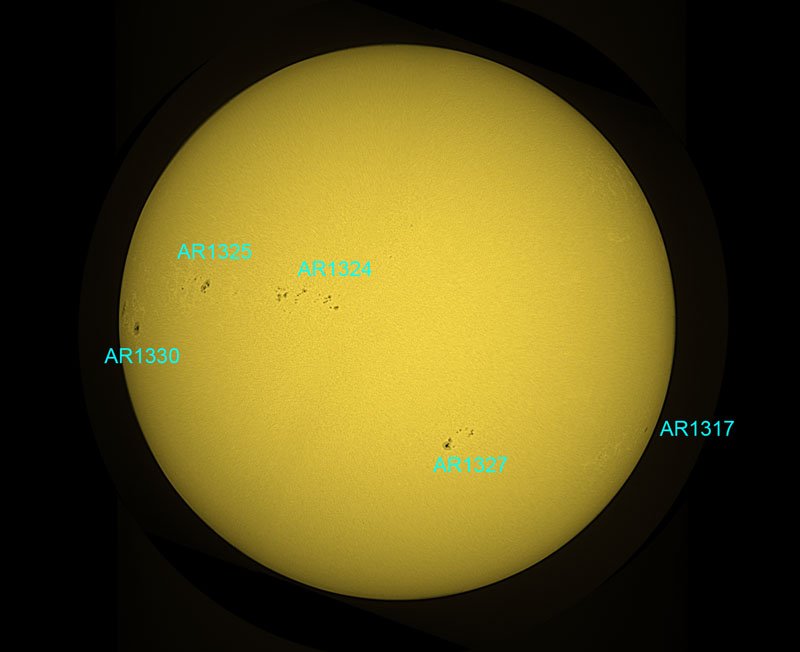 AR1330 on the left and AR1324, 25 on the right.
This is a 2x Barlow shot with the Stellarvue and an OIII filter for sharpness.
AR1330 on the left and AR1324, 25 on the right.
This is a 2x Barlow shot with the Stellarvue and an OIII filter for sharpness.
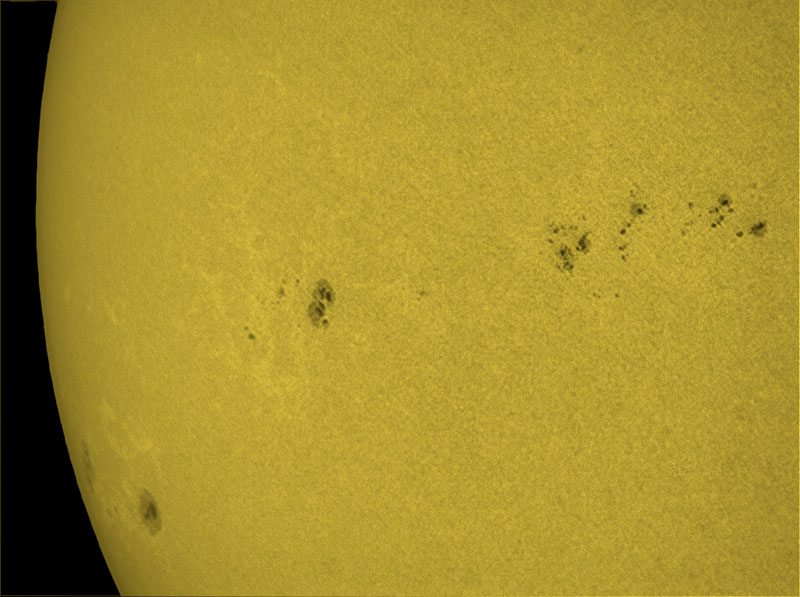 The Calcium K view for the full disk was made from two halfs shot with the Stellarvue
and the Lunt CaK module filter. This is the very first time I have tried this. Look at
the beautiful white chromospheric facula around the sunspot groups. I removed limb darkening
for this composite.
The Calcium K view for the full disk was made from two halfs shot with the Stellarvue
and the Lunt CaK module filter. This is the very first time I have tried this. Look at
the beautiful white chromospheric facula around the sunspot groups. I removed limb darkening
for this composite.
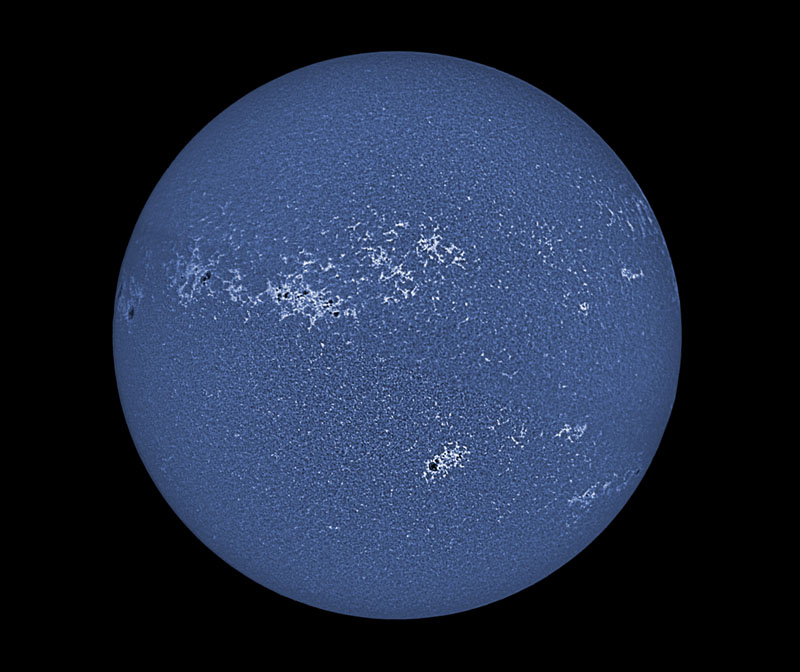 In CaK light, the Arcadia Prom was still visible, but much fainter. The white area just below it on the
disk is where the flare exploded.
In CaK light, the Arcadia Prom was still visible, but much fainter. The white area just below it on the
disk is where the flare exploded.
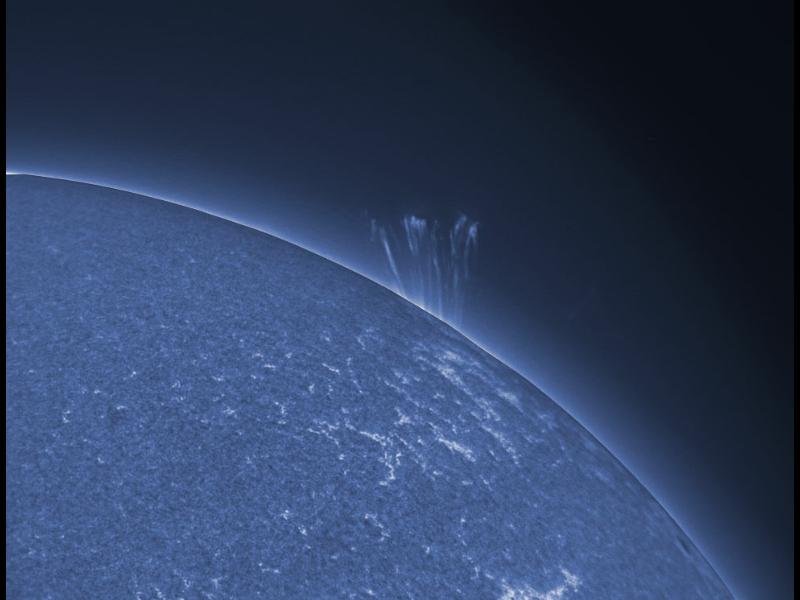 Some 2x close ups of the sunspot groups in Calcium light. Notice how it forms chains and loops. This shows
the outlines of the suns "super granulation" patterns.
Some 2x close ups of the sunspot groups in Calcium light. Notice how it forms chains and loops. This shows
the outlines of the suns "super granulation" patterns.
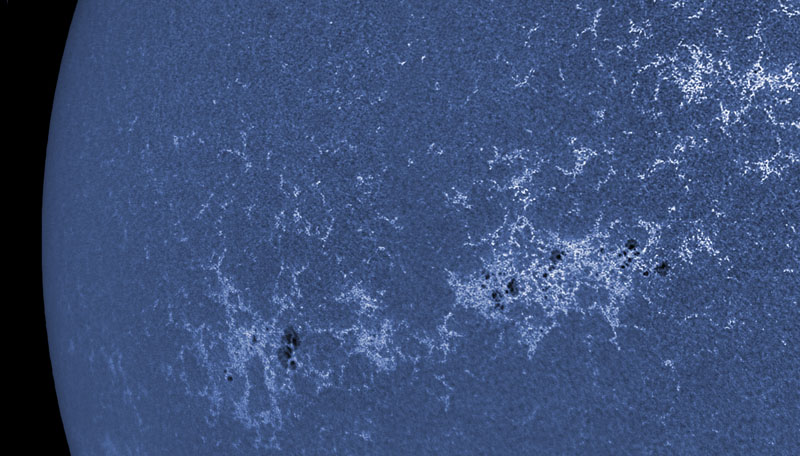 The outgoing limb we can see the sunspot AR1317 fading over the edge. We will not see it again.
The outgoing limb we can see the sunspot AR1317 fading over the edge. We will not see it again.
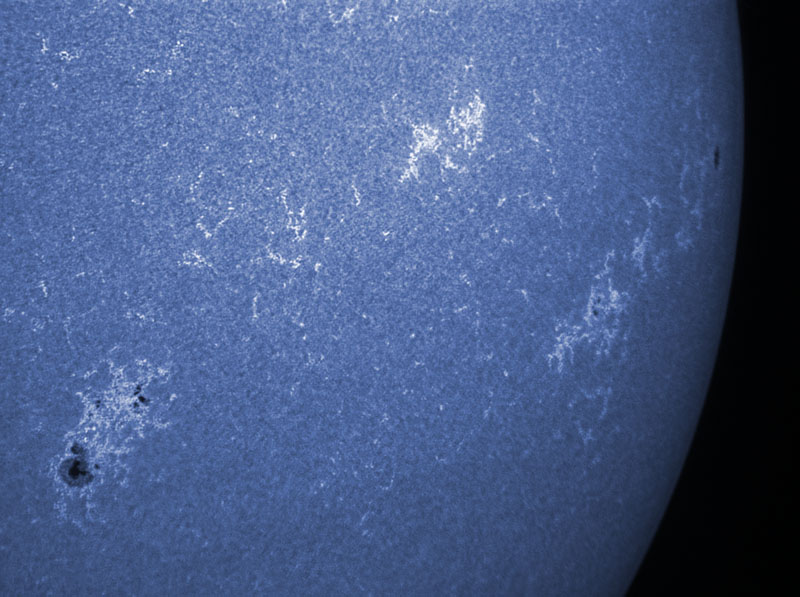 Hydrogen alpha images with the 40mm of the Arcadia Prominences. I was one of the few imagers on the
Cloudy nights forum (The largest and best in the world) that captured this event. This is the 3x Barlow.
Hydrogen alpha images with the 40mm of the Arcadia Prominences. I was one of the few imagers on the
Cloudy nights forum (The largest and best in the world) that captured this event. This is the 3x Barlow.
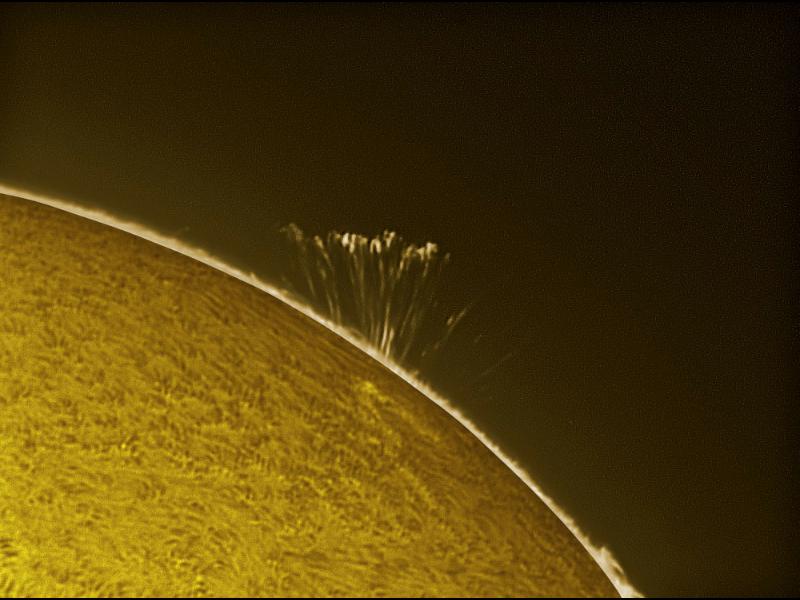 AR1324 and AR1325 were amazing sights in halpha. The latter is flaring here, seen as white burned in
areas. Just above it is a dark snake like structure, which is a prominence seen on the suns face. We call
these "Filaments".
AR1324 and AR1325 were amazing sights in halpha. The latter is flaring here, seen as white burned in
areas. Just above it is a dark snake like structure, which is a prominence seen on the suns face. We call
these "Filaments".
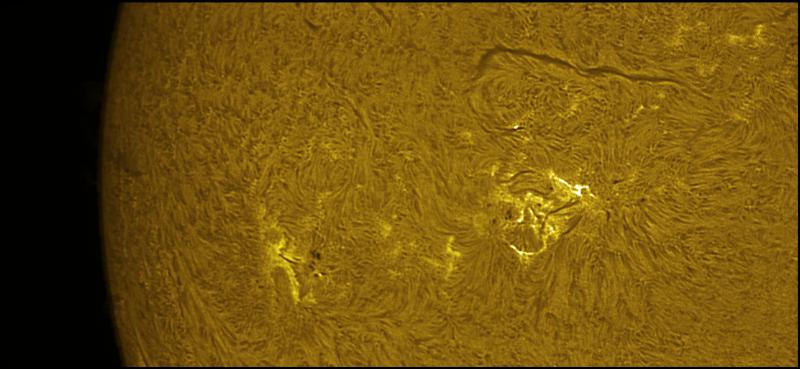 October 23, 2011
Sunday
Today was the day for high resolution work! I started (smartly) with the white light shots, and soon
found that the seeing was amazing. I also found that the best views were with no additional narrow
band filters, so these are in just plain white light with the Baader Astro solar safety film in front of
the SV80S. Here is the full disk shot to start. See how much the Sun rotates in one day?
October 23, 2011
Sunday
Today was the day for high resolution work! I started (smartly) with the white light shots, and soon
found that the seeing was amazing. I also found that the best views were with no additional narrow
band filters, so these are in just plain white light with the Baader Astro solar safety film in front of
the SV80S. Here is the full disk shot to start. See how much the Sun rotates in one day?
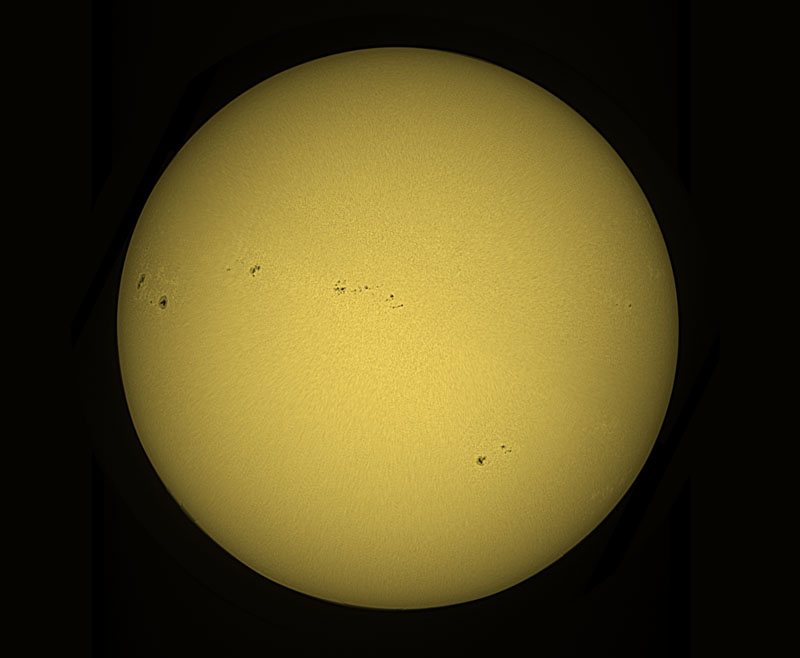 AR1330 is now further on to the oncoming disk. This is a shot with the SV80 and 2x Barlow, and OIII narrow
band filter. You can see at this magnification the beautiful white faculae around the sunspots.
AR1330 is now further on to the oncoming disk. This is a shot with the SV80 and 2x Barlow, and OIII narrow
band filter. You can see at this magnification the beautiful white faculae around the sunspots.
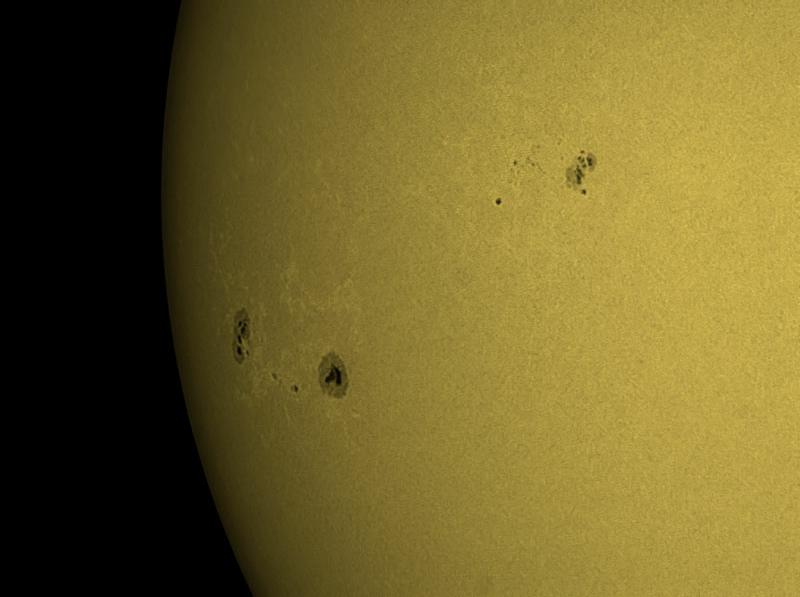 AR1324, one of the highest resolution images Ive ever taken of the Sun. Notice the granular pattern
in the background. This is the Solar Granulation, and is very difficult to photograph unless the seeing
is quite good. The granules which are all over the sun, average 2.5 arcseconds across. This spot group
contains many tiny pores and small spots all scattered across a long area! This is with the 5x Televue
Powermate Barlow.
AR1324, one of the highest resolution images Ive ever taken of the Sun. Notice the granular pattern
in the background. This is the Solar Granulation, and is very difficult to photograph unless the seeing
is quite good. The granules which are all over the sun, average 2.5 arcseconds across. This spot group
contains many tiny pores and small spots all scattered across a long area! This is with the 5x Televue
Powermate Barlow.
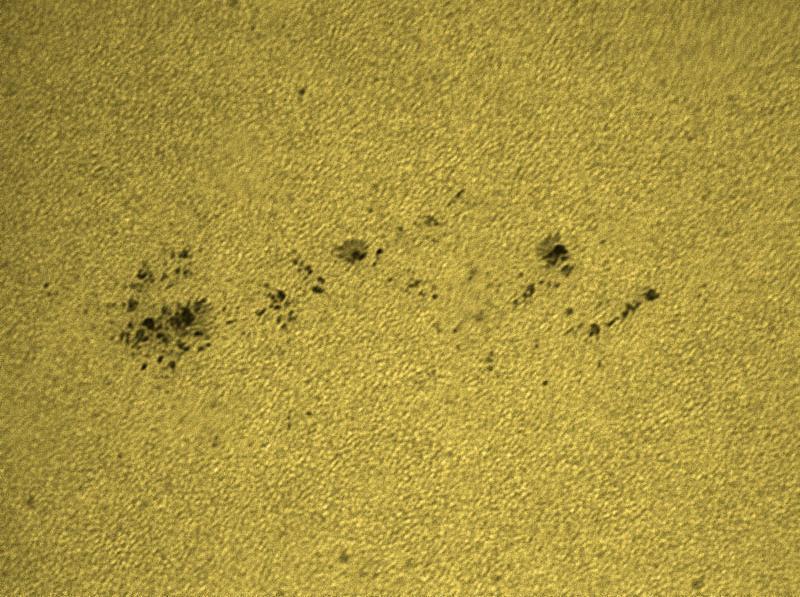 AR1330 at high resolution with the SV80, and 5x Barlow. Granulation is still easy on the right side, and fades
as we near the limb on the left. But look at the small which points making up the faculae! Oh how I wish such
a morning would occur more often... Both spots exhibit light bridges in them.
AR1330 at high resolution with the SV80, and 5x Barlow. Granulation is still easy on the right side, and fades
as we near the limb on the left. But look at the small which points making up the faculae! Oh how I wish such
a morning would occur more often... Both spots exhibit light bridges in them.
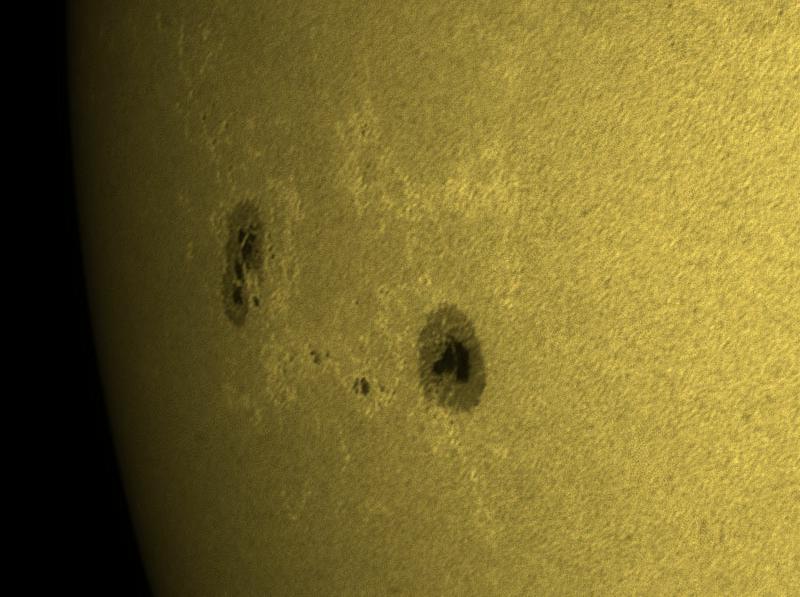 AR1327 is lonely, but has a great background with lots of granulation at 5x. It too has a nice light bridge
inside the umbra.
AR1327 is lonely, but has a great background with lots of granulation at 5x. It too has a nice light bridge
inside the umbra.
 Hydrogen alpha images also had extra ordinary detail today. This huge filament clearly shows its downward
pointing attachment pillars to the chromosphere. AR1325 just below it is flaring a bit.
Hydrogen alpha images also had extra ordinary detail today. This huge filament clearly shows its downward
pointing attachment pillars to the chromosphere. AR1325 just below it is flaring a bit.
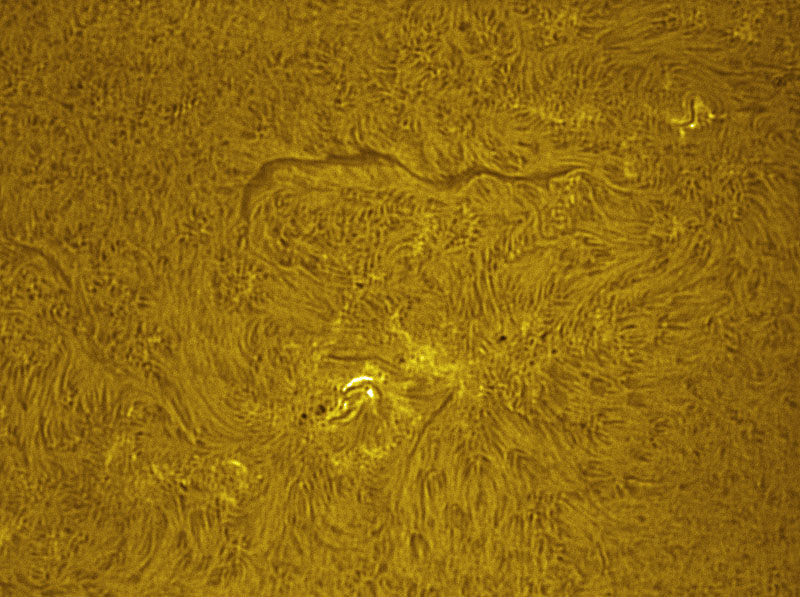 AR1327 looks like a bar magnet with its flux lines all around
AR1327 looks like a bar magnet with its flux lines all around
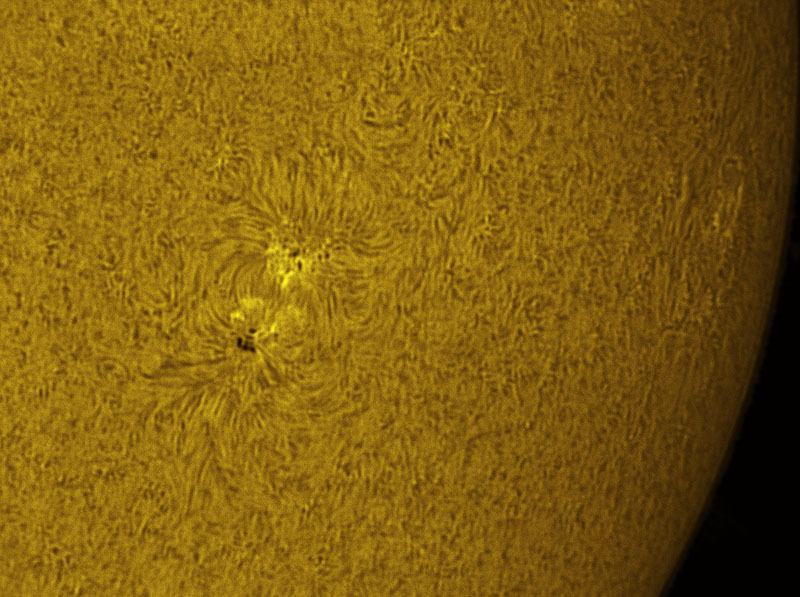 AR1330 is no less impressive in Halpha with the Coronado 40mm
AR1330 is no less impressive in Halpha with the Coronado 40mm
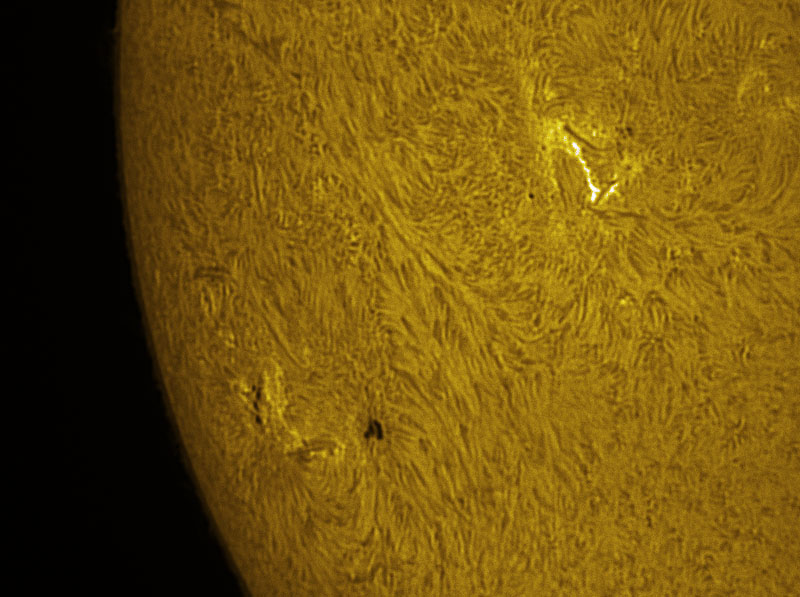
|
|
 Instrument: Coronado 40mm Halpha or Stellarvue SV80S
Platform: Astrophysics 1200
Camera: DMK 3U (1024x768)
Location: Payson, Arizona
Elevation: 5150 ft.
Sky: Seeing 9/10, Transparency 10/10
Outside Temperature: 75F
Processing: Registax 6, Photoshop CS2
Solar Home Page
HOME SCHMIDT GALAXIES EMISSION NEBS REFLECTION NEBS COMETS
GLOBULARS OPEN CLUST PLANETARIES LINKS
Instrument: Coronado 40mm Halpha or Stellarvue SV80S
Platform: Astrophysics 1200
Camera: DMK 3U (1024x768)
Location: Payson, Arizona
Elevation: 5150 ft.
Sky: Seeing 9/10, Transparency 10/10
Outside Temperature: 75F
Processing: Registax 6, Photoshop CS2
Solar Home Page
HOME SCHMIDT GALAXIES EMISSION NEBS REFLECTION NEBS COMETS
GLOBULARS OPEN CLUST PLANETARIES LINKS
|

Instrument: Coronado 40mm Halpha or Stellarvue SV80S Platform: Astrophysics 1200 Camera: DMK 3U (1024x768) Location: Payson, Arizona Elevation: 5150 ft. Sky: Seeing 9/10, Transparency 10/10 Outside Temperature: 75F Processing: Registax 6, Photoshop CS2 Solar Home Page HOME SCHMIDT GALAXIES EMISSION NEBS REFLECTION NEBS COMETS GLOBULARS OPEN CLUST PLANETARIES LINKS
 AR1330 on the left and AR1324, 25 on the right.
This is a 2x Barlow shot with the Stellarvue and an OIII filter for sharpness.
AR1330 on the left and AR1324, 25 on the right.
This is a 2x Barlow shot with the Stellarvue and an OIII filter for sharpness.
 The Calcium K view for the full disk was made from two halfs shot with the Stellarvue
and the Lunt CaK module filter. This is the very first time I have tried this. Look at
the beautiful white chromospheric facula around the sunspot groups. I removed limb darkening
for this composite.
The Calcium K view for the full disk was made from two halfs shot with the Stellarvue
and the Lunt CaK module filter. This is the very first time I have tried this. Look at
the beautiful white chromospheric facula around the sunspot groups. I removed limb darkening
for this composite.
 In CaK light, the Arcadia Prom was still visible, but much fainter. The white area just below it on the
disk is where the flare exploded.
In CaK light, the Arcadia Prom was still visible, but much fainter. The white area just below it on the
disk is where the flare exploded.
 Some 2x close ups of the sunspot groups in Calcium light. Notice how it forms chains and loops. This shows
the outlines of the suns "super granulation" patterns.
Some 2x close ups of the sunspot groups in Calcium light. Notice how it forms chains and loops. This shows
the outlines of the suns "super granulation" patterns.
 The outgoing limb we can see the sunspot AR1317 fading over the edge. We will not see it again.
The outgoing limb we can see the sunspot AR1317 fading over the edge. We will not see it again.
 Hydrogen alpha images with the 40mm of the Arcadia Prominences. I was one of the few imagers on the
Cloudy nights forum (The largest and best in the world) that captured this event. This is the 3x Barlow.
Hydrogen alpha images with the 40mm of the Arcadia Prominences. I was one of the few imagers on the
Cloudy nights forum (The largest and best in the world) that captured this event. This is the 3x Barlow.
 AR1324 and AR1325 were amazing sights in halpha. The latter is flaring here, seen as white burned in
areas. Just above it is a dark snake like structure, which is a prominence seen on the suns face. We call
these "Filaments".
AR1324 and AR1325 were amazing sights in halpha. The latter is flaring here, seen as white burned in
areas. Just above it is a dark snake like structure, which is a prominence seen on the suns face. We call
these "Filaments".
 October 23, 2011
Sunday
Today was the day for high resolution work! I started (smartly) with the white light shots, and soon
found that the seeing was amazing. I also found that the best views were with no additional narrow
band filters, so these are in just plain white light with the Baader Astro solar safety film in front of
the SV80S. Here is the full disk shot to start. See how much the Sun rotates in one day?
October 23, 2011
Sunday
Today was the day for high resolution work! I started (smartly) with the white light shots, and soon
found that the seeing was amazing. I also found that the best views were with no additional narrow
band filters, so these are in just plain white light with the Baader Astro solar safety film in front of
the SV80S. Here is the full disk shot to start. See how much the Sun rotates in one day?
 AR1330 is now further on to the oncoming disk. This is a shot with the SV80 and 2x Barlow, and OIII narrow
band filter. You can see at this magnification the beautiful white faculae around the sunspots.
AR1330 is now further on to the oncoming disk. This is a shot with the SV80 and 2x Barlow, and OIII narrow
band filter. You can see at this magnification the beautiful white faculae around the sunspots.
 AR1324, one of the highest resolution images Ive ever taken of the Sun. Notice the granular pattern
in the background. This is the Solar Granulation, and is very difficult to photograph unless the seeing
is quite good. The granules which are all over the sun, average 2.5 arcseconds across. This spot group
contains many tiny pores and small spots all scattered across a long area! This is with the 5x Televue
Powermate Barlow.
AR1324, one of the highest resolution images Ive ever taken of the Sun. Notice the granular pattern
in the background. This is the Solar Granulation, and is very difficult to photograph unless the seeing
is quite good. The granules which are all over the sun, average 2.5 arcseconds across. This spot group
contains many tiny pores and small spots all scattered across a long area! This is with the 5x Televue
Powermate Barlow.
 AR1330 at high resolution with the SV80, and 5x Barlow. Granulation is still easy on the right side, and fades
as we near the limb on the left. But look at the small which points making up the faculae! Oh how I wish such
a morning would occur more often... Both spots exhibit light bridges in them.
AR1330 at high resolution with the SV80, and 5x Barlow. Granulation is still easy on the right side, and fades
as we near the limb on the left. But look at the small which points making up the faculae! Oh how I wish such
a morning would occur more often... Both spots exhibit light bridges in them.
 AR1327 is lonely, but has a great background with lots of granulation at 5x. It too has a nice light bridge
inside the umbra.
AR1327 is lonely, but has a great background with lots of granulation at 5x. It too has a nice light bridge
inside the umbra.
 Hydrogen alpha images also had extra ordinary detail today. This huge filament clearly shows its downward
pointing attachment pillars to the chromosphere. AR1325 just below it is flaring a bit.
Hydrogen alpha images also had extra ordinary detail today. This huge filament clearly shows its downward
pointing attachment pillars to the chromosphere. AR1325 just below it is flaring a bit.
 AR1327 looks like a bar magnet with its flux lines all around
AR1327 looks like a bar magnet with its flux lines all around
 AR1330 is no less impressive in Halpha with the Coronado 40mm
AR1330 is no less impressive in Halpha with the Coronado 40mm
